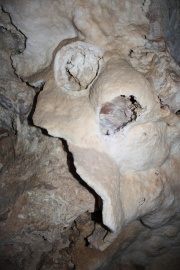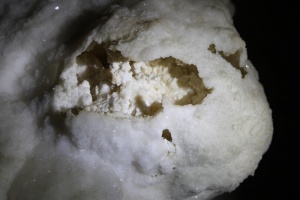Gypsum (Inventory)/Crust
From LagWiki
(Reference no longer needed) |
(Added an image) |
||
| Line 5: | Line 5: | ||
Gypsum crusts are often very fragile, brittle and easily broken if touched and though they sometimes appear substantial, they are not. The primary distinction between a gypsum crust and a [[Gypsum (Inventory)/Coating|gypsum coating]] is that a crust is less firmly adhered to the substructure. | Gypsum crusts are often very fragile, brittle and easily broken if touched and though they sometimes appear substantial, they are not. The primary distinction between a gypsum crust and a [[Gypsum (Inventory)/Coating|gypsum coating]] is that a crust is less firmly adhered to the substructure. | ||
| + | |||
| + | <gallery caption="Gallery" widths=300px heights=237px> | ||
| + | File:Gypsum crust 2.JPG|Gypsum crust | ||
| + | </gallery> | ||
==See also== | ==See also== | ||
Revision as of 04:51, 23 July 2013
The Crust field of the Gypsum section should be used to list stations where a crust of gypsum is observed.
A gypsum crust is a poorly adhered layer of gypsum usually over bedrock or breakdown. Often there will be noticeable space between the crust and the structure that it covers. It usually appears as white, crystaline layer but may be discolored by dirt, dust or any number of other stains. Gypsum crusts can vary in thickness from a millimeter up to a half meter thick and can have the appearance of snow packed against the bedrock.
Gypsum crusts are often very fragile, brittle and easily broken if touched and though they sometimes appear substantial, they are not. The primary distinction between a gypsum crust and a gypsum coating is that a crust is less firmly adhered to the substructure.
See also
References
- Palmer, Arthur N. (2007) Cave Geology CAVE BOOKS, Dayton, OH pp 289-290 ISBN-13: 978-0-939748-66-2, ISBN-10: 0-939748-66-5


